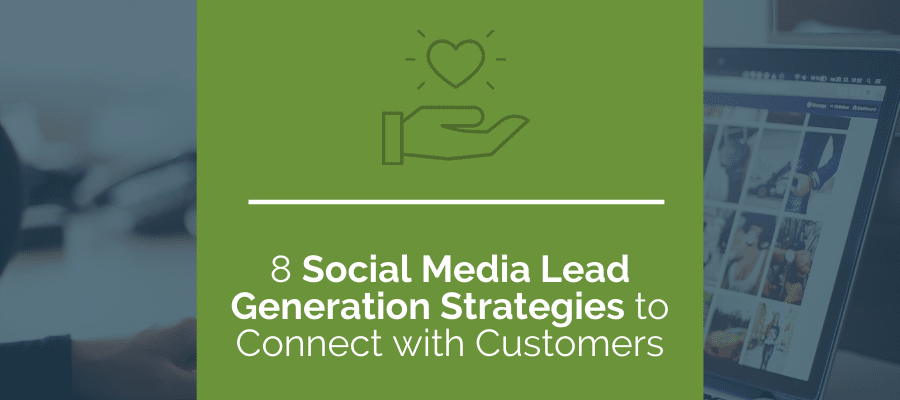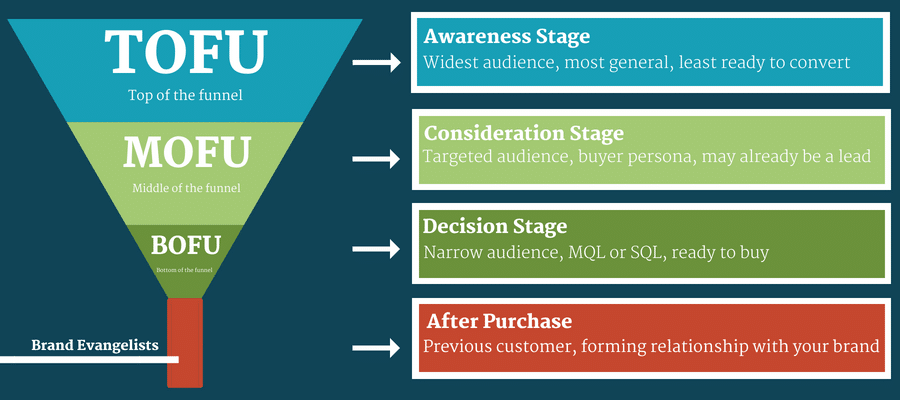
Social media has become a powerful tool for connecting with people around the world. Some businesses use social media to communicate with consumers, make connections, and reinforce their brand, while others have not found how their brand fits into the social media universe. It may be unclear how social media can lead to actual lead generation. Here are 8 social media lead generation strategies and tips that can help you see real value in your social media time.
8 Social Media Lead Generation Strategies to Connect with Customers
1. Define Your Goals
The first and most important question to ask yourself is; what do you want social media to do for you? If you want to use social media for lead generation, you’ll need a different approach than how you might use social media for brand promotion, visibility, and awareness. It’s possible to accomplish multiple goals at the same time, but it’s important to have a primary goal in mind to measure your success.
Remember that your goals will depend on your current social media activity and level of success, the type of business you run, your sales funnel, and what lead conversion means for you. If, for example, you are just starting out with social media marketing, your first goal might be to implement a tracking system and find your baseline. If you have this in place, then your next goal might be to increase leads relative to time or advertising dollar spent. Or, you might simply aim to increase general leads, marketing-qualified leads, or sales-qualified leads by a set percent.
If you are using social media for lead generation, you’ll need a measurable, attainable, but challenging goal to assess your strategy. Here are a few examples.
- Start tracking social media leads and generate 10 leads a month
- Implement a system for recording walk-in customers from social media, and generate 10 a month
- For every 1 hour weekly time increase spent on social media promotion, generate 1 more lead
- Increase social media advertising budget by 20% and increase lead generation by 5%
- Improve marketing-qualified leads from social media by 10%
- Increase lead conversions on social media landing page by 20%
2. Use a Tracking System
To measure the success of your social media lead generation strategy, you’ll need a way to track leads. Your ideal tracking system will depend on how a social media user becomes a lead, and how you define a lead.
For example, a local restaurant might define a lead as someone who visits their online ordering page from their social media profile, or someone who makes a reservation. A business that sells a more expensive item will probably have a longer sales funnel, and might define a lead as someone who downloads a brochure or signs up for a newsletter.
There are many ways to track users as they peruse your social media content, visit your site, download content, and even visit your store. Some of these are relatively simple to implement, but provide limited information, while others are more complicated, but provided detailed information.
- Special discount: Make a post about a particular discount only visible to social media uses. When visitors to your location mention the discount, you’ll know they came from your social media. This is a very simple, low-tech solution that can be effective. It’s easy to implement, but won’t provide much detailed information.
- Tracking link: use a tracking link on your social media profile. These are easy to create and they’ll give you information on traffic and some information on the user’s activity and origins. This is also easy to implement and can give you the important, basic data you need.
- Dedicated landing page: create a unique landing page for your social media and track visits or activity to this page alone. You might track this using the same platform you use to create the page, Google Analytics, your CRM system (see below), or another tool.
- Social analytics: most social platforms provide you with analytics. This might include information on traffic, new and repeat visitors, post visibility, advertising, and more. Combining this information with tracking links can give you more information to work with.
- CRM system: A CRM system gives you a sophisticated set of tools for monitoring all types of activity on your website and connected properties, like social media profiles. You can track what profiles a user visits, what pages they go to, what they do on those pages, whether they’ve been to your site before, and much more. This system is complex, and requires some time to get acquainted with. But, if you’re looking for granular data, a CRM system is hard to beat.
3. Measure Your Goals Accurately
Keep in mind; social media operates near the top of the sales funnel. The farther your goals are from the top of the funnel, the less accurately it will actually measure your social media success.
For example, say you want to improve sales-qualified leads generated from social media. However, a lead only becomes sales-qualified after they’ve completed other steps, such as downloading a lead magnet, talking with a sales rep, and undergoing a vetting process. Even if your social media activity is highly efficient in generating leads, other variables can cause sales-qualified leads to stagnant. A landing page might not be well-designed to entice downloads, a sales rep might not communicate with leads effectively, or the vetting process might be too constrained. If your goals are too far removed from your starting point, you won’t be accurately measuring your social media performance.
4. Match Your Platform and Your Audience

AirbnB leverages vacationers’ love of photos on their Instagram account. This is the a perfect marriage of audience, platform and content.
Different social media platforms appeal to different audiences just like different products and services do. Some have a wider appeal, like Facebook, while others are aimed at more specific audiences with specific interests, like SnapChat or Pinterest. Don’t assume that the best platform for your social media lead generation strategy is the one with the widest appeal.
When choosing a platform—or deciding which of your existing platforms to focus your time and energy on—it’s important to meet your audience where they’re most likely to find you. The following factors can help you decide. However, these are just predictors. You might get a more accurate assessment by simply polling your audience—perhaps through an in-store survey or email survey—and asking what type of social media they spend the most time on.
- Demographics: Different demographics gravitate towards or away from different platforms. Consider age, gender, and location in this decision, particularly country and native language—people from different countries often use different platforms.
- Scope: Consider how users on the platform organize themselves and their content. Is it easy to connect with users around the globe, or with local residents? Or, is the content organized into groups by interest? This can help you position your social media lead generation strategy properly.
- Existing audience: Where do you already have significant followers? Or, where are your competitors succeeding? This can be a good starting point, even if your demographics or scope don’t perfectly align at first.
5. Match Your Platform and Your Content
Once you’ve determined the platforms that your audience is using, you can whittle this list down further by matching your content with the platform. For example, let’s say you mostly want to produce video content. You’ve decided that YouTube, TikTok and Instagram are good choices. But, you mostly create long-form, instructional videos. In this case, you should probably focus on YouTube.
You might try and find the perfect platform for the content you’re best at creating, or create the perfect content for the platform you’re already on. Whichever way you go about, the following considerations can help you decide:
Type of content
Is your content mostly based on text, pictures, video, or audio? In general, text-based marketers should look at Facebook, Twitter, LinkedIn and micro-blogging platforms like Reddit or Tumblr. Picture-focused marketers should consider Instagram, Pinterest or SnapChat. Video-heavy campaigns should focus on YouTube, TikTok or Instagram as well. Audio campaigns are best for podcasts or might be successful on emergent social audio platforms, like Clubhouse.
Purpose
Is your content mostly informative, impressive, entertaining, or instructive? Consider how a given social media platform functions. Do users mostly scroll or search without much intent, looking for entertainment? Or are they actively looking for answers and finding communities? While there’s always some overlap, Pinterest and TikTok are good examples of entertaining social apps, while LinkedIn and YouTube are good examples of apps with purpose.
Length or complexity
Some platforms are better suited to short, simple content, while other platforms support longer, more in-depth content. Twitter is a good example of a text-based platform with mostly short, simple content. Reddit or Medium is a good example of a text-based platform with longer, more complex content. Consider what type of content you’re creating and where it fits.
6. Create Value for Your Audience
With your tracking system, goals and platform nailed down, your next social media lead generation strategy is what most people think of first; creating content that users actually interact with.
Put yourself in your customers’ shoes and consider what type of content you would click on. First, what are your customers looking for? Do they want to be informed, entertained, surprised or something else? Your brand identity can help you answer this question. If your brand is professional, grounded, and literal, informative content will probably be most valuable. However, overly-informative content might be too dry for a business that is more bold, edgy, and casual. This type of business might choose content that is entertaining, instead. A business that is bold, professional and artistic might not choose either; awe-inspiring or eye-catching content might work better.

Headspace uses a straight-forward social media lead generation strategy; discounts.
The next question that can help you create value for your audience is, what unique knowledge, benefit or experience can you provide? As an industry insider, you know things, experience things, or enjoy benefits that others don’t. Consider aspects of your business that you can show or explain that customers or potential customers will find interesting. These are just a few examples of content you might try.
- Discount or coupon code: this might be a discount on a new product, an annual membership, or something else.
- List of time- or money-savings tips: industry experts know how to make tedious tasks go faster and how to make products last longer. Share these tips with your audience.
- How it’s made: take your audience behind the scenes and show them how it’s made or what goes into your service.
- Polls: your audience can give you value as well. Put up a poll to ask about what new features, products, content or something else you should release.
- Easy access: give your social media followers special access to new products, services, or content.
- Tutorials: Maybe you know how to fix or maintain a product or complete a complicated task with ease. Show your audience how.
- AMA: Ask Me Anything invites followers to interact with you, and might give you a list of questions to elaborate on in the future.
- Just for laughs: With a cute, fun or zany brand personality, you probably have a few jokes or videos that your audience will enjoy as much as you do.
- Impress: a stunning photo or shocking statistic can impress your audience and encourage interactions.
- Before and after: show a dramatic transformation, such as you product going from a lump of raw materials to a finished item, or your service creating a beautiful result.
- Special events: highlight industry events and encourage followers to visit with you at those events.
- User-generated content: encourage users to take pictures, videos, or write about your product, and repost.
- Industry experts: talk to a famous or knowledgeable expert in your industry and ask questions that your customers would want to know the answers to.
7. Connect to Your Website
If you’re posting compelling content and driving engagement, you still won’t generate leads unless you give your audience a way to convert. Your audience must have a clear path that takes them from your social media content to a lead conversion opportunity.
There are a few ways to go about this, and which you choose will depend on your content type, your audience, your platform, website, and more. Though each platform is different, you’ll generally be able to include at least one link in your post or on your profile. This link should lead to a webpage that is relevant to the original content and also includes a clear lead conversion opportunity. Usually, this will be a form where a user can enter their name and email address, and get updates, discounts, newsletters, or other content intended to convert them from a lead to a customer.
- Social media landing page: Dedicate a landing page just to your social followers. You can track traffic and activity on this page by itself and change the page based on particular content or offers you’re promoting.
- Blog post: Businesses focused on text-based content might take their followers to a relevant blog post. You’ll need to change this link regularly to make sure it remains relevant.
- Promotions page: If you’re promoting a particular discount, product, new service or something else, you might take your followers to a particular promotional page.
- Lead magnet: A guide, webinar, course, brochure or other downloadable content can help turn followers into leads on your site.
8. Be a Part of the Conversation
Part of the appeal of social media is the sheer number of participants and the vast access to a diverse range of conversations and topics. The most impactful conversations involve the free share of information. Sometimes this is promotional, but not always. To be a part of this conversation and make an impact on your customers, promoting your own content isn’t enough.
Once again, consider what your customers are interested in, and how you can provide it. Assess your social media contacts; the people or companies you follow, the social leaders in your industry and on your platform of choice, your partners or associates, and groups you’re a part of. When you surround yourself with like-minded experts, you’ll position yourself to be a part of the conversation and you won’t have to curate all of your content yourself. You’ll need to dedicate some time to this conversation—perhaps a few minutes a day or an hour or so a week—to get value out of it.
- Share: Repost or share content from other users that matches the theme and intent of your own content.
- Comment: Weigh in on the conversation where you can and share your knowledge or expertise.
- Monitor: Use social media tracking tools to monitor the conversation around your brand and connect with people talking about you. Share positive mentions and address concerns.
Use these social media lead generation strategies to connect with customers on your platform of choice. Take these steps slowly, and figure out what content works best for your customers. With compelling content and a plan in place to turn followers into leads, you’ll be able to turn your social media platform into a real lead generation tool.

